(Author Michael Pearson on the road in Ireland. Courtesy photo)
By Tom Robotham
Over the last three decades, Michael Pearson—former professor of creative writing and literature at Old Dominion University—has written seven books of nonfiction focusing on his two great passions: reading and travel.
The two subjects are closely related, it seems to me. Books, after all, can take us to faraway places. They certainly served this purpose for Pearson when he was a boy, growing up in the Bronx, a fact that he underscored in his 1999 memoir Dreaming of Columbus—and one that he reiterates in his new book, The Road to Dungannon: Journeys in Literary Ireland.
“Our apartment was claustrophobic,” he writes in the prologue to the new volume, “and my father drowned his unhappiness in drink and cigarette smoke, often making the 500-square-foot home feel like a prison cell. Early on, books saved me, not metaphorically but truly, allowing me to find a way out of that space and into a world as big as my imagination could reach.”
Pearson decided early on, however, that he wanted to do more than live vicariously through the stories of others. He wanted to see things for himself. Thus, when it came time to write his first book, about American writers he admired, he didn’t simply pen essays of appreciation—he traveled to the places that had shaped the writers’ sensibilities, from Frost’s Vermont to Faulkner’s Mississippi.
After that, his ambitions broadened significantly, and in 2002, he embarked on his first of two trips around the world—journeys that he eventually chronicled in his book Innocents Abroad Too.
Taken together, his books offer a rich variety of colorful stories, acute observations, poignant reflections, and sharp literary insights. And yet, he notes in the new volume, they are bound together by a “connective tissue”: an Odyssean “sense of displacement and homelessness.”
THE NEW BOOK brings this into sharper focus, with a clear, central motive: to explore and contemplate his Irish roots and—more specifically—to try learn more about his maternal grandfather, Alfred Hunter, who emigrated from Northern Ireland to the Bronx, then abandoned his wife and children when Pearson’s mother was still an infant.
For Pearson, one key to understanding his Irish roots in general is to examine his ancestral homeland through the lens of the great Irish literary tradition and its key figures: James Joyce, chief among them, as well as W.B. Yeats, J.M. Synge, Frank O’Connor, Edna O’Brien, Seamus Heaney and contemporary authors who are carrying on the legacy.
There are chapters devoted to each, and within them Pearson moves deftly between Irish history, literary analysis, travelogue and memoir.

A central feature of Irish history, of course, is the devastating mid-19th century Potato Famine—or Great Famine, as it is known in Ireland—and Pearson offers an especially moving and vividly descriptive account of its impact, placing his grandfather in its context.
“Alfred’s parents would have made him aware of the Great Hunger, their holocaust,” he writes. “They would have described the blackened earth, the sickening smell, the deathly silence, the packs of feral dogs digging up the shallow graves of the famine dead, the emaciated women in rags carrying dead infants, the men walking twenty miles to distant towns for food because they were too proud to let their neighbors see them begging.”
The horrors of the famine were aggravated by the cruelty of the English ruling class, and Pearson brings this to the fore as well. “For many Irish,” he writes, “the English in general were genocidal monsters, and Edward Trevelyan, the Assistant Secretary for the Treasury…became the poster boy for the monumental indifference… Feeding the poor, he believed, would only exacerbate the Irish tendency toward sloth and dependence.”
The combination of the potato blight and political oppression spurred the desire among many Irish to flee, but those who came to America were met with the same sort of bigotry.
“By the time Alfred Hunter stepped onto American soil, and walked the streets of New York City in 1907 or 1908,” Pearson notes, “the…Irish Need Not Apply Signs…were less common, but they were still there and surely a fresh part of the communal memory.”
Less than a decade after Hunter left, meanwhile, the Irish revolted against English rule in what came to be known as the “Easter Rising” of 1916—an insurrection that led to the founding of the Irish Free State, and Pearson makes a powerful case that Irish literature was a driving force behind rebellion: that for the Irish, the writings of Yeats, Joyce and others were “a weapon as potent as dynamite…, as revolutionary as any Easter Rising, as subversive as a car bomb, and a way of attempting to repossess their country.”
FOR PEARSON, this body of literature serves as a means of understanding his ancestral heritage, and thus himself. In a wonderful chapter on Joyce, for example, he recalls his first encounter with the author’s short stories while a student at a Catholic high school in the Bronx, and how strongly they resonated with him. In the story “The Sisters,” for example, Pearson notes that the “silhouette of the Catholic Church fell upon the narrator’s life…just as that shadow fell over mine.”
In the same chapter, Pearson has much to say about Joyce’s masterpiece Ulysses as well, and if you’ve always meant to get around to that book—or are inclined to reread it—I recommend the chapter on Joyce as an introduction. Ditto, if you decide to delve into the works of Yeats, Synge, O’Connor, O’Brien and Heaney, not to mention contemporary Irish literature, which Pearson explores in his final chapter, “Writers of the New Ireland.” Indeed, if I ever were to teach a class on Irish literature, The Road to Dungannon would certainly be required reading.
There are many other great books on Irish literature, of course, but what sets Pearson’s apart is his viscerally personal approach, which at times takes on an almost cosmic sense of synchronicity. How strange is it, for example, that the real-life inspiration for Leopold Bloom in Ulysses was a man also named Alfred Hunter.
“I imagined that…Alfred Hunter’s benevolence might have been some part of my grandfather’s nature,” Pearson writes. “Could he have abandoned my mother and disappeared forever for some reason that would allow me to forgive him?”
In the end, he offers no pat answer to this question, but instead embraces the complexity of the human condition: “In my dreams,” he writes, “my grandfather can be the darkness or the light, and sometimes both at the same time.
This sums up his thoughts about Ireland as well.
“At a certain point in my imaginative journey through Irish literature and my physical wanderings around Ireland,” he writes, “I began to hope that I had come to terms with the island in the manner that critic and novelist Thomas Flanagan had—‘It is not the romantic, rather sentimental Ireland of many Irish Americans that I love, but the actual Ireland, a complex, profound, historical society, woven of many strands, some bright and some dark.”
That said, there is a lot more light in the book than darkness, and love far outweighs any lingering resentments.
“Alfred Hunter abandoned my mother and her family,” he writes on the last page of the book. “For that, she never forgave him. But he left me a legacy of love—for Ireland, its people and its literature.”




